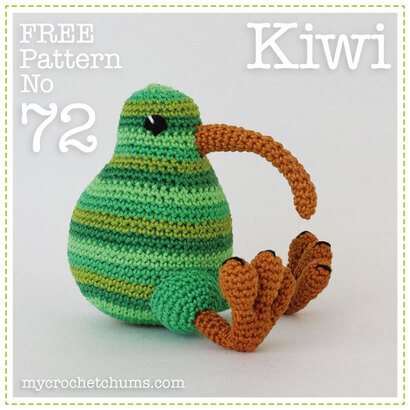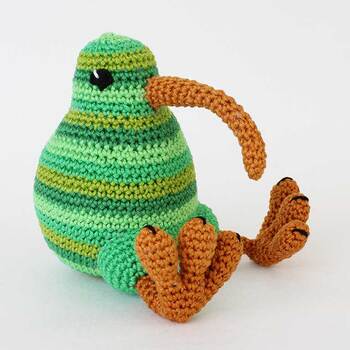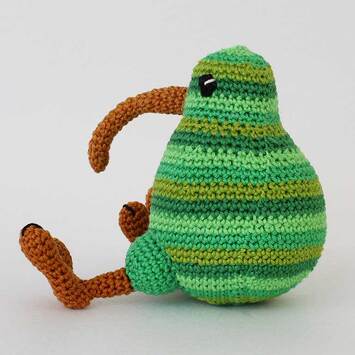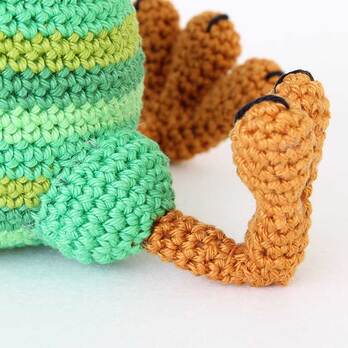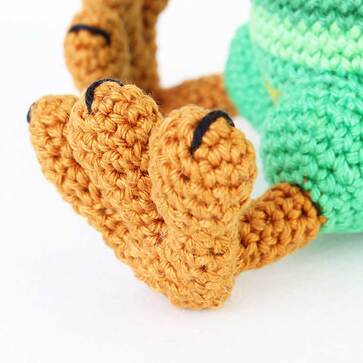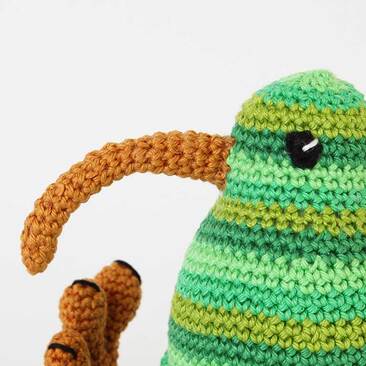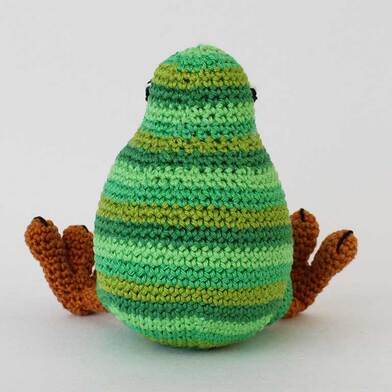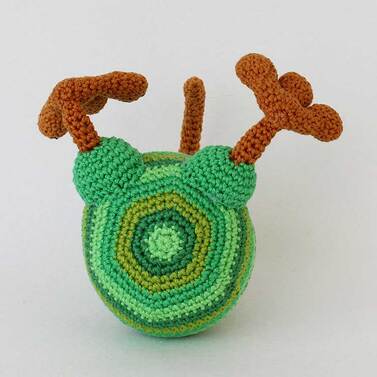Free Amigurumi Crochet Kiwi Pattern
Let's get started...
Yarn
Scheepjes Catona. 100% Cotton. 125m per 50g.
MC: 15g approx of Ginger Gold (383) for Beak, Feet and Legs.
CC1: 15g approx of Apple Green (389) for Body and Legs.
CC2: 10g approx of Kiwi (205) for Body.
CC3: 10g approx of Apple Granny (513) for Body.
CC4: 10g approx of Emerald (515) for Body.
CC5: 5g approx of Jet Black (110) for Eyes and Embroidered Details.
CC6: Small amount of Snow White (106) for Eye Highlight.
A cotton yarn works well for Ami as it gives good stitch definition and creates a firm structure so body parts hold their shape well. Scheepjes Catona is a relatively thick 4 ply (US: Sport) - you can substitute a DK Cotton (US: DK/Light Worsted) with a similar amount of metres per 50g.
You can scale this pattern up or down by altering the yarn and hook. Use a heavier weight yarn and larger hook for a bigger Kiwi and a lighter weight yarn and smaller hook for a little one.
To read more about scaling an Amigurumi pattern up or down, check out my guide HERE.
Scheepjes Catona. 100% Cotton. 125m per 50g.
MC: 15g approx of Ginger Gold (383) for Beak, Feet and Legs.
CC1: 15g approx of Apple Green (389) for Body and Legs.
CC2: 10g approx of Kiwi (205) for Body.
CC3: 10g approx of Apple Granny (513) for Body.
CC4: 10g approx of Emerald (515) for Body.
CC5: 5g approx of Jet Black (110) for Eyes and Embroidered Details.
CC6: Small amount of Snow White (106) for Eye Highlight.
A cotton yarn works well for Ami as it gives good stitch definition and creates a firm structure so body parts hold their shape well. Scheepjes Catona is a relatively thick 4 ply (US: Sport) - you can substitute a DK Cotton (US: DK/Light Worsted) with a similar amount of metres per 50g.
You can scale this pattern up or down by altering the yarn and hook. Use a heavier weight yarn and larger hook for a bigger Kiwi and a lighter weight yarn and smaller hook for a little one.
To read more about scaling an Amigurumi pattern up or down, check out my guide HERE.
Hook
2 mm - for the yarn specified above.
2 mm - for the yarn specified above.
Other Supplies
Yarn needle, toy stuffing, stitch marker/waste yarn, pins and scissors.
Yarn needle, toy stuffing, stitch marker/waste yarn, pins and scissors.
Tension
27 st x 30 rows = 10 cm measured over UK dc using 2mm hook with Scheepjes Catona 4 ply cotton.
Tension is not critical for this project but stitches should be tight enough to avoid stuffing showing through.
27 st x 30 rows = 10 cm measured over UK dc using 2mm hook with Scheepjes Catona 4 ply cotton.
Tension is not critical for this project but stitches should be tight enough to avoid stuffing showing through.
Size
Body is 12cm (4.75 in) approx from base to top. Beak is 7.5cm (3 in) long.
Body is 12cm (4.75 in) approx from base to top. Beak is 7.5cm (3 in) long.
Pattern Notes
The Kiwi is made using joined rounds so that there are no jagged steps between the colours. Full instructions are given in the Body part of the pattern but you can also find a Photo Tutorial showing the principle of the Joined Rounds technique HERE.
Use a stitch marker or waste yarn to keep track of the first stitch of each round. You can find a Photo Tutorial about using waste yarn as a stitch marker HERE.
If you don't want to make a Magic Ring you can start each piece by making a chain of 2 and then work the first round into the second chain from the hook.
If you'd like to start with a Magic Ring but don’t know how, you can find a Photo Tutorial HERE.
The Kiwi is made of multiple separate pieces sewn together. Unless otherwise stated, finish each piece by pulling the yarn through the last loop and leave a long tail for sewing. Any loose tails at the end can be easily woven in.
UK Crochet Terms - Abbreviations
The pattern below is written using UK Crochet Terms - they are NOT the same as US ones - please familiarise yourself with the UK terms to avoid your character’s shape distorting!
The “dc” abbreviation used in this pattern refers to UK double crochet. The equivalent stitch in US terms is single crochet - if you are used to US patterns you need to work single crochet everywhere this pattern says “dc”. If you work US dc (equivalent to UK Treble) the finished item will be elongated and the stuffing will show through.
The Kiwi is made using joined rounds so that there are no jagged steps between the colours. Full instructions are given in the Body part of the pattern but you can also find a Photo Tutorial showing the principle of the Joined Rounds technique HERE.
Use a stitch marker or waste yarn to keep track of the first stitch of each round. You can find a Photo Tutorial about using waste yarn as a stitch marker HERE.
If you don't want to make a Magic Ring you can start each piece by making a chain of 2 and then work the first round into the second chain from the hook.
If you'd like to start with a Magic Ring but don’t know how, you can find a Photo Tutorial HERE.
The Kiwi is made of multiple separate pieces sewn together. Unless otherwise stated, finish each piece by pulling the yarn through the last loop and leave a long tail for sewing. Any loose tails at the end can be easily woven in.
UK Crochet Terms - Abbreviations
The pattern below is written using UK Crochet Terms - they are NOT the same as US ones - please familiarise yourself with the UK terms to avoid your character’s shape distorting!
The “dc” abbreviation used in this pattern refers to UK double crochet. The equivalent stitch in US terms is single crochet - if you are used to US patterns you need to work single crochet everywhere this pattern says “dc”. If you work US dc (equivalent to UK Treble) the finished item will be elongated and the stuffing will show through.
Increasing and decreasing
You may use either standard increases and decreases in this pattern or, for a much neater finish, invisible ones. FLO = Front loop only.
Decrease - "dc2tog" in pattern.
Standard Decrease: Insert hook in next st, yrh, pull through stitch (2 loops on hook), insert hook in next st, yrh, pull up a loop (3 loops on hook), yrh, pull through all 3 loops on hook.
Invisible decrease: Insert hook in FLO of the two stitches to be decreased, yrh, pull through both front loops, yrh, pull through two loops on hook.
Increase - "2 dc in next st" in pattern.
Standard Increase: Work 2 dc in next st.
Invisible Increase: Work 1 dc in FLO of next st and 1 dc in both loops of same st.
You may use either standard increases and decreases in this pattern or, for a much neater finish, invisible ones. FLO = Front loop only.
Decrease - "dc2tog" in pattern.
Standard Decrease: Insert hook in next st, yrh, pull through stitch (2 loops on hook), insert hook in next st, yrh, pull up a loop (3 loops on hook), yrh, pull through all 3 loops on hook.
Invisible decrease: Insert hook in FLO of the two stitches to be decreased, yrh, pull through both front loops, yrh, pull through two loops on hook.
Increase - "2 dc in next st" in pattern.
Standard Increase: Work 2 dc in next st.
Invisible Increase: Work 1 dc in FLO of next st and 1 dc in both loops of same st.
Body
Made using joined rounds. Join each round with a sl st in BLO of beg dc, then work first st of next round into both loops of same dc as join. From the second joined round onwards, make sure you miss the sl st from the prev round, do not work into this rather than the beg dc by mistake. The sl st joins don't count in the st count. Made from the bottom up. Stuff as you go.
Rnd 1: With CC3, working into a magic ring, 6 dc. Join in BLO. 6 sts
Rnd 2: 2 dc in each st around. Join. 12 sts
Change to CC4.
Rnd 3: [1 dc, 2 dc in next st] 6 times. Join. 18 sts
Rnd 4: [2 dc, 2 dc in next st] 6 times. Join. 24 sts
Change to CC2.
Rnd 5: [3 dc, 2 dc in next st] 6 times. Join. 30 sts
Rnd 6: [4 dc, 2 dc in next st] 6 times. Join. 36 sts
Change to CC1.
Rnd 7: [5 dc, 2 dc in next st] 6 times. Join. 42 sts
Rnd 8: [6 dc, 2 dc in next st] 6 times. Join. 48 sts
Change to CC3.
Rnd 9: [7 dc, 2 dc in next st] 6 times. Join. 54 sts
Rnd 10: [8 dc, 2 dc in next st] 6 times. Join. 60 sts
Change to CC4.
Rnds 11-12: Dc around. Join.
Change to CC2.
Rnds 13-14: Dc around. Join.
Change to CC1.
Rnds 15-16: Dc around. Join.
Change to CC3.
Rnds 17-18: Dc around. Join.
Change to CC4.
Rnds 19-20: Dc around. Join.
Change to CC2.
Rnd 21: Dc around. Join.
Rnd 22: [8 dc, 1 dc2tog] 6 times. Join. 54 sts
Change to CC1.
Rnds 23-24: Dc around. Join.
Change to CC3.
Rnd 25: 3 dc, 1 dc2tog, 5 dc, 1 dc2tog, 11 dc, 1 dc2tog, 5 dc, 1 dc2tog, 11 dc, 1 dc2tog, 5 dc, 1 dc2tog, 2 dc. Join. 48 sts
Rnd 26: Dc around. Join.
Change to CC4.
Rnd 27: 2 dc, 1 dc2tog, 4 dc, 1 dc2tog, 10 dc, 1 dc2tog, 4 dc, 1 dc2tog, 10 dc, 1 dc2tog, 4 dc, 1 dc2tog, 2 dc. Join. 42 sts
Rnd 28: Dc around. Join.
Change to CC2.
Rnd 29: 2 dc, 1 dc2tog, 3 dc, 1 dc2tog, 9 dc, 1 dc2tog, 3 dc, 1 dc2tog, 9 dc, 1 dc2tog, 3 dc, 1 dc2tog, 1 dc. Join. 36 sts
Rnd 30: 1 dc, 1 dc2tog, 2 dc, 1 dc2tog, 8 dc, 1 dc2tog, 2 dc, 1 dc2tog, 8 dc, 1 dc2tog, 2 dc, 1 dc2tog, 1 dc. Join. 30 sts
Change to CC1.
Rnds 31-32: Dc around. Join.
Change to CC3.
Rnds 33-34: Dc around. Join.
Change to CC4.
Rnds 35-36: Dc around. Join.
Change to CC2.
Rnds 37-38: Dc around. Join.
Change to CC1.
Rnd 39: [3 dc, 1 dc2tog] 6 times. Join. 24 sts
Rnd 40: [2 dc, 1 dc2tog] 6 times. Join. 18 sts
Change to CC3.
Rnd 41: [1 dc, 1 dc2tog] 6 times. Join. 12 sts
Rnd 42: 6 dc2tog. Join. 6 sts
Fasten off. Weave yarn tail through FLO of last 6 sts and pull to close hole. Weave in end.
Made using joined rounds. Join each round with a sl st in BLO of beg dc, then work first st of next round into both loops of same dc as join. From the second joined round onwards, make sure you miss the sl st from the prev round, do not work into this rather than the beg dc by mistake. The sl st joins don't count in the st count. Made from the bottom up. Stuff as you go.
Rnd 1: With CC3, working into a magic ring, 6 dc. Join in BLO. 6 sts
Rnd 2: 2 dc in each st around. Join. 12 sts
Change to CC4.
Rnd 3: [1 dc, 2 dc in next st] 6 times. Join. 18 sts
Rnd 4: [2 dc, 2 dc in next st] 6 times. Join. 24 sts
Change to CC2.
Rnd 5: [3 dc, 2 dc in next st] 6 times. Join. 30 sts
Rnd 6: [4 dc, 2 dc in next st] 6 times. Join. 36 sts
Change to CC1.
Rnd 7: [5 dc, 2 dc in next st] 6 times. Join. 42 sts
Rnd 8: [6 dc, 2 dc in next st] 6 times. Join. 48 sts
Change to CC3.
Rnd 9: [7 dc, 2 dc in next st] 6 times. Join. 54 sts
Rnd 10: [8 dc, 2 dc in next st] 6 times. Join. 60 sts
Change to CC4.
Rnds 11-12: Dc around. Join.
Change to CC2.
Rnds 13-14: Dc around. Join.
Change to CC1.
Rnds 15-16: Dc around. Join.
Change to CC3.
Rnds 17-18: Dc around. Join.
Change to CC4.
Rnds 19-20: Dc around. Join.
Change to CC2.
Rnd 21: Dc around. Join.
Rnd 22: [8 dc, 1 dc2tog] 6 times. Join. 54 sts
Change to CC1.
Rnds 23-24: Dc around. Join.
Change to CC3.
Rnd 25: 3 dc, 1 dc2tog, 5 dc, 1 dc2tog, 11 dc, 1 dc2tog, 5 dc, 1 dc2tog, 11 dc, 1 dc2tog, 5 dc, 1 dc2tog, 2 dc. Join. 48 sts
Rnd 26: Dc around. Join.
Change to CC4.
Rnd 27: 2 dc, 1 dc2tog, 4 dc, 1 dc2tog, 10 dc, 1 dc2tog, 4 dc, 1 dc2tog, 10 dc, 1 dc2tog, 4 dc, 1 dc2tog, 2 dc. Join. 42 sts
Rnd 28: Dc around. Join.
Change to CC2.
Rnd 29: 2 dc, 1 dc2tog, 3 dc, 1 dc2tog, 9 dc, 1 dc2tog, 3 dc, 1 dc2tog, 9 dc, 1 dc2tog, 3 dc, 1 dc2tog, 1 dc. Join. 36 sts
Rnd 30: 1 dc, 1 dc2tog, 2 dc, 1 dc2tog, 8 dc, 1 dc2tog, 2 dc, 1 dc2tog, 8 dc, 1 dc2tog, 2 dc, 1 dc2tog, 1 dc. Join. 30 sts
Change to CC1.
Rnds 31-32: Dc around. Join.
Change to CC3.
Rnds 33-34: Dc around. Join.
Change to CC4.
Rnds 35-36: Dc around. Join.
Change to CC2.
Rnds 37-38: Dc around. Join.
Change to CC1.
Rnd 39: [3 dc, 1 dc2tog] 6 times. Join. 24 sts
Rnd 40: [2 dc, 1 dc2tog] 6 times. Join. 18 sts
Change to CC3.
Rnd 41: [1 dc, 1 dc2tog] 6 times. Join. 12 sts
Rnd 42: 6 dc2tog. Join. 6 sts
Fasten off. Weave yarn tail through FLO of last 6 sts and pull to close hole. Weave in end.
Legs - make 2
Made from the bottom up. Feet are made separately to Legs. Stuff as you go.
Rnd 1: With MC, working into a magic ring, 6 dc. 6 sts
Rnd 2: Dc around in BLO.
Rnds 3-7: Dc around.
Change to CC1.
Rnd 8: 2 dc in each st around in FLO. 12 sts
Rnd 9: [1 dc, 2 dc in next st] 6 times. 18 sts
Rnd 10: [2 dc, 2 dc in next st] 6 times. 24 sts
Rnds 11-12: Dc around.
Rnd 13: [2 dc, 1 dc2tog] 6 times. 18 sts
Fasten off. Leave a long yarn tail to sew the Leg to the Body once you've made all the parts.
Made from the bottom up. Feet are made separately to Legs. Stuff as you go.
Rnd 1: With MC, working into a magic ring, 6 dc. 6 sts
Rnd 2: Dc around in BLO.
Rnds 3-7: Dc around.
Change to CC1.
Rnd 8: 2 dc in each st around in FLO. 12 sts
Rnd 9: [1 dc, 2 dc in next st] 6 times. 18 sts
Rnd 10: [2 dc, 2 dc in next st] 6 times. 24 sts
Rnds 11-12: Dc around.
Rnd 13: [2 dc, 1 dc2tog] 6 times. 18 sts
Fasten off. Leave a long yarn tail to sew the Leg to the Body once you've made all the parts.
Feet - make 2
The three Toes - Toe A, B and C - of each foot are made separately and then crocheted together. The Toes are made from their top down. Stuff as you go.
To make Toes A & B:
Rnd 1: With MC, working into a magic ring, 6 dc. 6 sts
Rnd 2: 2 dc in each st around. 12 sts
Rnds 3-4: Dc around.
Rnd 5: [2 dc, 1 dc2tog] 3 times. 9 sts
Rnd 6: Dc around.
Rnd 7: [1 dc, 1 dc2tog] 3 times. 6 sts
Rnd 8: Dc around.
Fasten off. The next unused stitch, where you would start the next round if there was one, is the first stitch you will work into when you join the Toes later in Rnd 9 below. Leave a yarn tail long enough to weave in once the foot is complete.
To make Toe C:
Work as Toes A & B above but don't fasten off at the end of Rnd 8. In Rnd 9, you will be working into the next unused stitch of each Toe. Continue on to Rnd 9 below.
To join the Toes together:
Rnd 9: Starting in the next unused stitch of the specified Toes work: 3 dc in Toe C, 3 dc in Toe B, rotating as you go, 6dc in Toe A, 3 dc in Toe B and 3 dc in Toe C. 18 sts
It is usual for there to be small gaps between the toes when joined - these can be stitched closed with a length of MC and a yarn needle once the Foot is completed.
Rnd 10: Dc around. 18 sts
Rnd 11: [1 dc, 1 dc2tog] 6 times. 12 sts
Rnd 12: Dc around.
Rnd 13: 6 dc2tog. 6 sts
Fasten off. Weave yarn tail through FLO of last 6 sts and pull to close hole. Weave in all ends.
The three Toes - Toe A, B and C - of each foot are made separately and then crocheted together. The Toes are made from their top down. Stuff as you go.
To make Toes A & B:
Rnd 1: With MC, working into a magic ring, 6 dc. 6 sts
Rnd 2: 2 dc in each st around. 12 sts
Rnds 3-4: Dc around.
Rnd 5: [2 dc, 1 dc2tog] 3 times. 9 sts
Rnd 6: Dc around.
Rnd 7: [1 dc, 1 dc2tog] 3 times. 6 sts
Rnd 8: Dc around.
Fasten off. The next unused stitch, where you would start the next round if there was one, is the first stitch you will work into when you join the Toes later in Rnd 9 below. Leave a yarn tail long enough to weave in once the foot is complete.
To make Toe C:
Work as Toes A & B above but don't fasten off at the end of Rnd 8. In Rnd 9, you will be working into the next unused stitch of each Toe. Continue on to Rnd 9 below.
To join the Toes together:
Rnd 9: Starting in the next unused stitch of the specified Toes work: 3 dc in Toe C, 3 dc in Toe B, rotating as you go, 6dc in Toe A, 3 dc in Toe B and 3 dc in Toe C. 18 sts
It is usual for there to be small gaps between the toes when joined - these can be stitched closed with a length of MC and a yarn needle once the Foot is completed.
Rnd 10: Dc around. 18 sts
Rnd 11: [1 dc, 1 dc2tog] 6 times. 12 sts
Rnd 12: Dc around.
Rnd 13: 6 dc2tog. 6 sts
Fasten off. Weave yarn tail through FLO of last 6 sts and pull to close hole. Weave in all ends.
Beak
Made from the tip of the Beak back towards the Body. The increases and decreases create the curve of the Beak. Stuff as you go.
Rnd 1: With MC, working into a magic ring, 4 dc. 4 sts
Rnd 2: [1 dc, 2 dc in next st] twice. 6 sts
Rnd 3: Dc around.
Rnd 4: 2 dc in next st, 5 dc. 7 sts
Rnd 5: 2 dc in next st, 2 dc, 1 dc2tog, 2 dc. 7 sts
Rnd 6: Rep Rnd 5.
Rnd 7: 1 dc, 2 dc in next st, 2 dc, 1 dc2tog, 1 dc. 7 sts
Rnd 8: Rep Rnd 7.
Rnd 9: 2 dc, 2 dc in next st, 2 dc, 1 dc2tog. 7 sts
Rnd 10: Rep Rnd 9.
Rnd 11: Dc around.
Rnd 12: 1 dc2tog, 2 dc, 2 dc in next st, 2 dc. 7 sts
Rnd 13: Rep Rnd 12.
Rnd 14: 3 dc, [2 dc in next st] twice, 2 dc. 9 sts
Rnds 15-19: Dc around.
Fasten off. Leave a long yarn tail to sew the Beak to the Body once you've made all the parts.
Made from the tip of the Beak back towards the Body. The increases and decreases create the curve of the Beak. Stuff as you go.
Rnd 1: With MC, working into a magic ring, 4 dc. 4 sts
Rnd 2: [1 dc, 2 dc in next st] twice. 6 sts
Rnd 3: Dc around.
Rnd 4: 2 dc in next st, 5 dc. 7 sts
Rnd 5: 2 dc in next st, 2 dc, 1 dc2tog, 2 dc. 7 sts
Rnd 6: Rep Rnd 5.
Rnd 7: 1 dc, 2 dc in next st, 2 dc, 1 dc2tog, 1 dc. 7 sts
Rnd 8: Rep Rnd 7.
Rnd 9: 2 dc, 2 dc in next st, 2 dc, 1 dc2tog. 7 sts
Rnd 10: Rep Rnd 9.
Rnd 11: Dc around.
Rnd 12: 1 dc2tog, 2 dc, 2 dc in next st, 2 dc. 7 sts
Rnd 13: Rep Rnd 12.
Rnd 14: 3 dc, [2 dc in next st] twice, 2 dc. 9 sts
Rnds 15-19: Dc around.
Fasten off. Leave a long yarn tail to sew the Beak to the Body once you've made all the parts.
Eyes - make 2
Do not stuff.
Rnd 1: With CC5 and working into a magic ring, 4 dc. Slip stitch in first dc to join. 4 sts
Fasten off. Leave a long yarn tail to sew the Eye to the Head once you've made all the parts.
Do not stuff.
Rnd 1: With CC5 and working into a magic ring, 4 dc. Slip stitch in first dc to join. 4 sts
Fasten off. Leave a long yarn tail to sew the Eye to the Head once you've made all the parts.
Making Up
- Using the photographs as a guide, pin the pieces together before sewing, checking from all angles to make sure you’re happy with the positioning, then use the long yarn tails or a length of yarn with a yarn needle to stitch the pieces together.
- There's a Photo Tutorial about sewing Amigurumi parts together seamlessly HERE.
- Looking at the Body, the more prominent, rounded area is the bottom of the Kiwi's back. See the picture above, showing the Kiwi from the side.
- Before you start positioning the pieces, you may find it helpful to insert a line of pins running down the front centre line of the Body, taking them under the base and up the back - this will help you to position everything else evenly in relation to the central line. Remove any pins that are in the way of the pieces you are attaching as you go.
- If the previous paragraph has confused you, there's a Photo Tutorial about using Pin Lines to help position amigurumi parts on the website - you can find it HERE.
- Sew the Feet to the bottom of the Legs.
- Making sure the tops of the Legs are well stuffed, sew them, with the Feet facing forwards and up, to the front of the Body, set forward slightly so the Kiwi can sit on his bottom. They should be placed about 6 sts apart.
- Sew the Beak in place, with its top edge sitting roughly 7 rnds down from the top of the Head.
- Sew the Eyes in place on either side of the Head, with their top edge sitting roughly 1 rnd above the top of the Beak.
Embroidered Details
Use a length of CC6 with a yarn needle to embroider the single stitch highlight onto the Eyes. If you don't have any White yarn, the lightest green will be fine.
Use a length of CC5 to embroider the claws on the Kiwi's toes.
All done!
Use a length of CC6 with a yarn needle to embroider the single stitch highlight onto the Eyes. If you don't have any White yarn, the lightest green will be fine.
Use a length of CC5 to embroider the claws on the Kiwi's toes.
All done!
Terms of Use
I am happy for you to donate, gift or sell any of the my crochet chums you make if you are an individual crafter - please credit mycrochetchums.com as the pattern designer. The patterns can not be used for any type of mass production or manufacturing.
If you do wish to sell your my crochet chums, it is your responsibility to ensure that the finished item complies with the relevant toy safety legislation in your country.
Please be sure to use toy grade stuffing and do not add buttons, bells, ribbons etc that could be a danger to small children.
You may print your PDF for personal use only (not for redistribution).
The patterns, files and all images are copyright protected and are not for commercial use. No part of the patterns may be sold, reproduced, transmitted, broadcast, translated, used for derivative works or published in any form.
I am happy for you to donate, gift or sell any of the my crochet chums you make if you are an individual crafter - please credit mycrochetchums.com as the pattern designer. The patterns can not be used for any type of mass production or manufacturing.
If you do wish to sell your my crochet chums, it is your responsibility to ensure that the finished item complies with the relevant toy safety legislation in your country.
Please be sure to use toy grade stuffing and do not add buttons, bells, ribbons etc that could be a danger to small children.
You may print your PDF for personal use only (not for redistribution).
The patterns, files and all images are copyright protected and are not for commercial use. No part of the patterns may be sold, reproduced, transmitted, broadcast, translated, used for derivative works or published in any form.
About mycrochetchums
I started mycrochetchums at the end of 2020 to give me something to focus on during lockdown and to make creative use of a box of Amigurumi Yarn that was an impulse purchase I was feeling guilty about!
I’m loving creating these cute characters and sharpening my tech skills in the process as I wrangle with managing a website and social media.
Check out the mycrochetchums Facebook page - drop me a message there if you have any feedback about the pattern or would like to share a picture of the end result.
You can also find me on Instagram @mycrochetchums.
If you have any questions about any of my patterns (or any other ami you may be working on) please email me at: [email protected] - I’ll do my best to help!
Happy Crocheting!
Pia x
©2023PIA SIMPSON/ MYCROCHETCHUMS
I started mycrochetchums at the end of 2020 to give me something to focus on during lockdown and to make creative use of a box of Amigurumi Yarn that was an impulse purchase I was feeling guilty about!
I’m loving creating these cute characters and sharpening my tech skills in the process as I wrangle with managing a website and social media.
Check out the mycrochetchums Facebook page - drop me a message there if you have any feedback about the pattern or would like to share a picture of the end result.
You can also find me on Instagram @mycrochetchums.
If you have any questions about any of my patterns (or any other ami you may be working on) please email me at: [email protected] - I’ll do my best to help!
Happy Crocheting!
Pia x
©2023PIA SIMPSON/ MYCROCHETCHUMS

